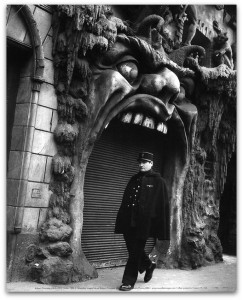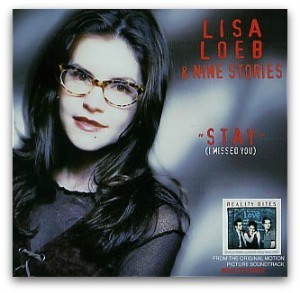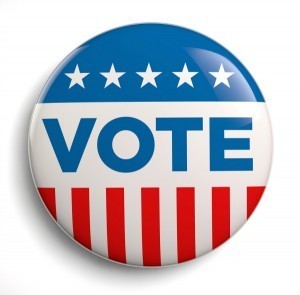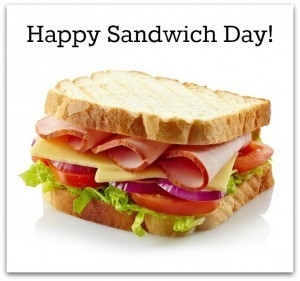Bathroom Readers' Institute's Blog, page 125
November 11, 2014
Impossible Questions: Fast Money Edition
Think you know the answer to this question? Think you can get it? Good luck…and come back tomorrow to see if you’re right.
How did an NFL star change the way you bank?
Need more impossible questions? Check out Uncle John’s Impossible Questions.
_____________________________________
Want more astounding facts and fascinating trivia?
Our annual holiday sale is happening now.
The post Impossible Questions: Fast Money Edition appeared first on .
November 10, 2014
4 Bands Who Said No to Lucrative Reunion Offers
What’s a more powerful force than money? Not wanting to be anywhere near your old bandmates who drove you crazy.
 Led Zeppelin
Led ZeppelinThe news of a Led Zeppelin reunion tour is just now breaking…because it isn’t going to happen. Richard Brandon of Virgin offered the three surviving members of the classic rock supergroup $800 million to reunite for 35 concerts. (It was really a series of three residencies, with multiple shows in London, Berlin, and New Jersey.) Robert Planet, Jimmy Page, and John Paul Jones each would have each been paid $200 million for performance, and split $100 million in merchandising profits. But at a final meeting with concert promoters, Plant literally tore up the contract, deciding that he didn’t want to do the reunion after all.
ABBA
In 2000, ABBA was hip again thanks to Mamma Mia!, a hit musical in London and New York built around the band’s 1970s disco-pop. One of the bestselling bands worldwide of all time (reportedly second only to the Beatles) a concert promoter offered the four members of the Swedish group $1 billion to reunite for 100 shows in 2000. At the one time ABBA’s two male members were married to the two female members…not not anymore, and the band had permanently split in 1982. “We have never made a comeback,” said member Bjorn Ulvaeus. “Almost everyone else has. I think there’s a message in that.”
The Smiths
The annual Coachella Valley Music and Arts Festival, held annually in California, has frequently featured a reunited classic band, such as Jane’s Addiction, the Stooges, Pixies, and Bauhaus. In 2005, organizers offered the Smiths $5 million to play a single set at that year’s concert. The Smiths were one of the most influential bands of the 1980s, at the forefront of alternative rock and “Britpop,” but broke up in 1987 (followed by the band members suing each other). Frontman Morrissey nixed the reunion, telling a reporter, “I’d rather eat my own testicles than reform the Smiths, and that’s saying something for a vegetarian.”
The Beatles
The Fab Four never reunited after their acrimonious split in 1970, and John Lennon and George Harrison have since passed away. In the mid-1970s, concert promoter Bill Sargent offered the Beatles $10 million to play a single concert, likely at Shea Stadium, that was also going to feature the Rolling Stones and Bob Dylan. It didn’t happen, even when he offered $50 million, and even when he offered $100 million.
_____________________________________
Want more astounding facts and fascinating trivia?
Our annual holiday sale is happening now.
The post 4 Bands Who Said No to Lucrative Reunion Offers appeared first on .
Ask Uncle John Anything: Tangled Up, Blue
Uncle John knows pretty much everything—and if he doesn’t, he heads his massive research library, or puts one of his many associates on the case. So go ahead: In the comments below, ask Uncle John anything. (And if we answer your question sometime, we’ll send you a free book!)
 How do cords get tangled up all on their own?
How do cords get tangled up all on their own?
It’s the strangest phenomenon—you take out your earbuds, and being in too much of a rush to properly wind and tie them up, you throw them into a coat pocket. The next day, you go to retrieve them and find that the long cords—evidently independently of any external force—have gone and tangled, knotted, and bunched themselves up. The pocket was undisturbed, even; there wasn’t anything else in the pocket to throw a wrench in the works, as it were. How and why does this happen? (And why does this also happen to holiday lights in a box in the basement, a power cord under your desk…?)
Believe it or not, there’s a scientific discipline devoted to understanding why this happens, and it’s called knot theory. Brilliant minds in this (admittedly small) discipline have discovered with math that there is almost a 100 percent chance that something that can knot in storage will not in storage. That’s because for while there is only one way for a cord to be untangled, there are hundreds of ways for it to get tangled—there are countless types of knots, all just a little bit different than each other, and they can occur and combine with each other in just as many if not more ways.
Anyplace on the cord in which it can bend is called a contact point. The more contact points on a long cord, the more possibilities there are for the cord to bend and thus knot itself. But even the tiniest change in environment can cause those contact points to bend, move, and touch, ones you didn’t even think about. Say those headphones are in your coat pocket and you placed the coat gently over a chair. That little bit of motion is enough to make the cord bend. Walking with the coat on can make the cord move, and subsequently knot. Even slight temperature changes can wreak havoc.
_____________________________________
Want more astounding facts and fascinating trivia?
Our annual holiday sale is happening now.
The post Ask Uncle John Anything: Tangled Up, Blue appeared first on .
November 7, 2014
3 of the Coolest Bars in the World (That Are No Longer Open)
We recently told you about some of the world’s scariest bars . While those may remind you of the dead, these dearly departed watering holes around the world are, sadly, truly and completely dead.
 Cabaret de l’Enfer (Paris)
Cabaret de l’Enfer (Paris)This hell-themed bar was one of the hippest in Paris at the turn of the century. The exterior, which featured nightmarish decor and a door shaped like the head of a demon, still appears on postcards in many of the city’s gift shops. Inside, elaborate stage shows featured live snakes and an actor running around in a devil outfit who heckled the patrons. Despite the fiery ambiance, which included smoke and flame effects, the management often fought with the bar’s heating system. Result: It was often too cold to hang out in the bar that looked like Hell. Cabaret de l’Enfer was so popular that it inspired a heavenly bar next door called Cabaret du Ciel. It featured waitresses in angel outfits and an actor dressed as Saint Peter. Sadly, both of them went to the big lounge in the sky by the 1950s.
The Stone Balloon (Newark, Delaware)
This bar was once beloved by students at the University of Delaware and was known for its live music. Bruce Springsteen and Metallica both played sets there and MTV even used it for a broadcast during the network’s early days. What made the Stone Balloon so popular? During its 33 years in business, it sold over 20,000 mugs that could be filled with beer on Thursdays for only a buck a round. Needless to say, the bar was once one of Budweiser’s largest accounts in America. Rolling Stone once called the Stone Balloon “the best kept secret in rock and roll.” Alas, it closed forever in 2005 and was replaced by condos.
Peter Cat (Tokyo)
Before he hit it big as a writer, acclaimed novelist Haruki Murakami once ran a coffeehouse and jazz bar with his wife in Tokyo’s Shibuya District. They named it after his old pet cat, Peter. Murakami, who used the business to pay his bills while he worked on a writing career, didn’t have high hopes that it would be successful. Instead, their somewhat unusual business scheme (serve coffee during the day, serve booze at night) worked out pretty well. Peter Cat was often, literally, packed. The tiny space featured a grand piano and barely enough room for both patrons and the bands that played music there. They eventually moved Peter Cat to a larger location. Murakami and his wife added a Cheshire Cat sign outside and lots of purr-fect decorations inside. They closed Peter Cat for good in 1981 when Murakami started to gain notice as one of the finest contemporary novelists.
The post 3 of the Coolest Bars in the World (That Are No Longer Open) appeared first on .
November 4, 2014
3 Weird NFL Contract Stipulations
We already gave you some weird sports contract quirks. Here are some from pro football.
 Bench pressed
Bench pressedAkili Smith was the starting quarterback for the Cincinnati Bengals in 2000. He earned $275,000, but it would’ve jump to a whopping $4 million if he threw for more 1,600 yards. He threw an impressive 1,253 in ten games and was certainly on track to reach his milestone. But then in the 11th game of the season, he was benched. Did the Bengals do it on purpose, to save $3 million?
Young and rich
Quarterback Steve Young was a top NFL prospect in 1984…but he signed with the upstart USFL instead. The Los Angeles Express offered him a lucrative $40 million, ten-year contract, even though they had nowhere near enough cash on hand to pay him that much. Young agreed to accept $34.5 million of the contract as an annuity. So even though the USFL folded in 1986, Young will continue to collect a $3.17 million check each year until 2027.
Barry unmotivated
Barry Sanders is one of the best running backs to ever play in the NFL. He apparently didn’t have to work too hard in the offseason to be that great, either. He skipped both voluntary workouts and mandator minicamps offered by his team, the Detroit Lions, in 1999. He also had a clause in his contract that provided $100,000 if he regularly lifted weights at a team facility in the offseason. He preferred having free time to the extra cash.
The post 3 Weird NFL Contract Stipulations appeared first on .
4 Hit Songs From Flop Movies
When a pop song is released from a movie, it’s meant to promote the movie. But sometimes the song is a huge hit in its own right…and the movie bombs.
 The 1994 movie Reality Bites attempted to capture the zeitgiest of Generation X, following around a young woman as she finishes graduate school and tries to find her place in the world. It was well received, but made just $20 million. Co-star Ethan Hawke recommended to director Ben Stiller a song by his neighbor, Lisa Loeb, a struggling coffeehouse singer. Loeb’s “Stay” made the movie and went to #1, the first time ever a singer without a recording contract topped the charts.
The 1994 movie Reality Bites attempted to capture the zeitgiest of Generation X, following around a young woman as she finishes graduate school and tries to find her place in the world. It was well received, but made just $20 million. Co-star Ethan Hawke recommended to director Ben Stiller a song by his neighbor, Lisa Loeb, a struggling coffeehouse singer. Loeb’s “Stay” made the movie and went to #1, the first time ever a singer without a recording contract topped the charts.
Xanadu, the film, was a mess. A musical about a muse taking human form (Olivia Newton-John) to help open a roller disco (really) flopped, earning just $1.4 million on its opening weekend. But five of its songs, written and produced by Electric Light Orchestra’s Jeff Lynne, were huge hits. “Magic” by Newton-John spent four weeks at #1, “Xanadu” reached #2, “Suddenly” went to #20, and two ELO songs, “All Over the World” and “I’m Alive,” were among the biggest hits the band ever had.
Foul-mouthed comedian Andrew “Dice” Clay was very popular in the late 1980s. But by the time his movie The Adventures of Ford Fairlane was released in July 1990, audiences had soured on Clay. He’d been involved in several controversial instances, including an ill-fated gig hosting Saturday Night Live, in which which female cast and crew had sat out in protest. Fairlane flopped at the box office, and won Worst Picture at the Razzies. But its soundtrack song “Cradle of Love” by Billy Idol dominated radio and MTV throughout the year. It peaked at #2 on the pop chart.
You Light Up My Life was a romantic comedy about an aspiring singer released in the summer of 1977, when Star Wars dominated the box office. Grease costar Didi Conn lip-synced the title song in the movie, which was sung by a session singer named Kasey Cisyk. It was then re-recorded by Debby Boone, daughter of 1950s singer Pat Boone, as her first ever release. The movie was sparsely attended, but “You Light Up My Life” was huge. It spent 10 weeks at #1 (at the time, a record), won the Academy Award for Best Song, and then Song of the Year at the Grammys.
_____________________________________
Want more astounding facts and fascinating trivia?
Our annual holiday sale is happening now.
The post 4 Hit Songs From Flop Movies appeared first on .
November 3, 2014
The Closest Ever Senate and House Elections
Who says that down-ticket elections aren’t exciting? Here are three stories of very close elections.
 After 20 years of service, New Hampshire senator Norris Cotton declined to seek reelection in 1974. Vying for his seat that fall were state insurance commissioner John Durkin and congressional representative Louis Wyman. Wyman was expected to win, and he did…by just 355 votes. Durkin asked for a recount, which gave him the win by a margin of only 10 votes. Another recount was then held, which gave Wyman a victory by, amazingly, two votes. Durkin asked the U.S. Senate to review the election, which declared the seat vacant after eight months of deliberation. In September 1975, a new election was held, which Durkin won handily by an 11 percent margin.
After 20 years of service, New Hampshire senator Norris Cotton declined to seek reelection in 1974. Vying for his seat that fall were state insurance commissioner John Durkin and congressional representative Louis Wyman. Wyman was expected to win, and he did…by just 355 votes. Durkin asked for a recount, which gave him the win by a margin of only 10 votes. Another recount was then held, which gave Wyman a victory by, amazingly, two votes. Durkin asked the U.S. Senate to review the election, which declared the seat vacant after eight months of deliberation. In September 1975, a new election was held, which Durkin won handily by an 11 percent margin.
In 1984, Rick McIntyre beat out incumbent Frank McCloskey to represent Indiana’s eighth congressional distict by just 34 votes out of more than 230,000 filed. However, Indiana’s secretary of state ignored instant recounts which found McCloskey to be the winner, and certified McIntyre anyway. Indiana’s state house conducted another recount and re-certified McCloskey with a margin of only four votes.
A lot of Democrats lost their spots in the House and Senate during the “Republican Revolution” elections of 1994. It looked like Connecticut representative Sam Gejdenson would lose his, too. But when all of the votes were counted, and recounted, and then recounted again, he held his seat by 21 votes. (Gejdenson was ultimately voted out in 2000, losing to Rob Simmons, who lost his seat six years later by a mere 83 votes.)
The post The Closest Ever Senate and House Elections appeared first on .
Weird November “Holidays” You Ought to Celebrate
November boasts Veterans Day, Thanksgiving, and, of course, Absurdity Day.
 Nov. 3: Sandwich Day, and Housewife’s Day
Nov. 3: Sandwich Day, and Housewife’s DayToday does double duty, so why not show you appreciate all the work of a stay-at-home mom you know, and make her a sandwich.
Nov. 8: Dunce Day
Have you ever seen (or been) a kid who gave too many wrong answers in class and was forced to wear a dunce cap out of shame? It comes from medieval Scottish scolar Duns Scotus, who believed that wearing conical hats increased intelligence. He died on this day in 1308, and this is his (and his namesake cap’s) holiday.
Nov. 13: National Indian Pudding Day
In advance of Thanksgiving, this day gives a nod to sweet desserts made by peoples native to North America. They generally were made from some combination of apples, cornmeal, and molasses.
Nov. 14: World Diabetes Day
Appropriately enough, the day after the day celebrating sweet, rich desserts is a day devoted to diabetes awareness.
Nov. 16: Have a Party With Your Bear Day
Don’t worry—this isn’t a day to go befriend grizzly bears or polar bears. Supporters use this day to throw parties for their favorite teddy bears (which is maybe scarier than trying to befriend a real bear).
Nov. 19: Have a Bad Day Day
Bad days are a part of life, and this holiday seeks to acknowledge them, which help us not take good days for granted. So go ahead and have a bad day today.
Nov. 20: Absurdity Day
This one doesn’t make any sense. Literally.
Nov. 27: Pins and Needles Day
Are people that anxious about Thanksgiving? Maybe, but the day is actually a commemoration of the opening of the Labor movement Broadway play Pins and Needles in 1937.
Nov. 28: Red Planet Day
The first major mission to Mars was the Mariner 4, which launched on November 28, 1964 and got within 6,100 miles of the Red Planet. On this day, take some time to appreciate the fourth rock from the sun.
Nov. 30: Stay at Home Because You Are Well Day
Creators of this holiday urge you to call in “well” to work and play hooky—why skip work when you’re too sick to enjoy skipping work?
The post Weird November “Holidays” You Ought to Celebrate appeared first on .
October 31, 2014
The Library of the Future
There’s no telling what libraries will look like a century from now…or if they’ll even exist. Nevertheless, a unique project currently underway in Norway is ensuring that they’ll have a least a few new books on their shelves.
 The project is called the Future Library and it was created by the Berlin-based artist Katie Paterson. Beginning in 2014, its organizers will request an unpublished work from a famous writer every year for the next 100 years. Then, in 2114, they’ll all be published using paper harvested from a forest that was planted earlier this year. Between now and then, the manuscripts will be stored in a specially designed room in Oslo’s New Public Deichmanske Library.
The project is called the Future Library and it was created by the Berlin-based artist Katie Paterson. Beginning in 2014, its organizers will request an unpublished work from a famous writer every year for the next 100 years. Then, in 2114, they’ll all be published using paper harvested from a forest that was planted earlier this year. Between now and then, the manuscripts will be stored in a specially designed room in Oslo’s New Public Deichmanske Library.
Paterson came up with the idea, which is one part publishing house, one part library, and one part time capsule, several years ago while “daydreaming about tree rings” and contemplating the future of print media.
Margaret Atwood, the acclaimed writer of The Handmaid’s Tale, was the first author to receive an invite from the Future Library. She contributed a book but future entrants may wind up submitting everything from screenplays to poems. “I am very honored, and also happy to be part of this endeavor,” Atwood told the press “This project, at least, believes the human race will still be around in a hundred years!” Here’s a video featuring her further thoughts on the project.
There’s also the question of whether or not humans, if they’re still around, will have the time, or inclination, to read words printed on paper, let alone anything written all the way back in the early 21st century. Will anyone in the year 2114 want to read Atwood’s book? Only time will tell.
The post The Library of the Future appeared first on .
October 28, 2014
3 Halloween Candy Origins
How the stuff you steal out of your kid’s treat bag came to be.
Fun Size
 Was there a house in your neighborhood that was legendary for giving out “full size” candy bars on Halloween? A lot more people used to do that, up until 1961, when Mars introduced miniature, snack, or tiny candy bars, sold in bags, specifically to hand out to Trick-or-Treaters. The term “fun size” was coined in 1968, and the first fun size candies available were Snickers and Milky Way, and later on, Three Musketeers and M&Ms (in little bags, not little bars). “Fun size” was used exclusively by Mars, until the Curtiss Candy Co. started using it for its Halloween versions of Baby Ruth and Butterfinger. Mars unsuccessfully sued in 1972, and the “fun” was shared.
Was there a house in your neighborhood that was legendary for giving out “full size” candy bars on Halloween? A lot more people used to do that, up until 1961, when Mars introduced miniature, snack, or tiny candy bars, sold in bags, specifically to hand out to Trick-or-Treaters. The term “fun size” was coined in 1968, and the first fun size candies available were Snickers and Milky Way, and later on, Three Musketeers and M&Ms (in little bags, not little bars). “Fun size” was used exclusively by Mars, until the Curtiss Candy Co. started using it for its Halloween versions of Baby Ruth and Butterfinger. Mars unsuccessfully sued in 1972, and the “fun” was shared.
Candy Corn
Candy maker George Renninger of the Wunderlee Candy Company in Philadelphia came up with the idea in the late 1880s to make candy that resembled corn kernels, only bigger and more brightly colored. The tri-colored candy bits were created by mixing sugar, water, and corn syrup in large kettles, with fondant and marshmallow added for smoothness. Then they poured the mixture into the molds, adding food dyes and only doing one color at a time. Appropriately enough, candy corn was at first a big hit with farmers. Today, the candy is made by machines: A tray of kernel molds are filled with cornstarch. Then the white section is added, then the orange, then the yellow. The only big difference in the recipe is that the sugar has been replaced with, ironically, high fructose corn syrup.
Mary Janes
These old-fashioned candies are basically taffy—really, really hard taffy made with molasses and little pieces of peanuts in them. This year, Mary Janes celebrate their 100th birthday. Charles N. Miller of the Charles N. Miller Candy Company came up with the idea (named after his aunt) when making candy with his father at home, in a house that was once owned by Paul Revere. Today, Mary Janes are made by the same company that makes Necco wafers in, ironically, the city of Revere, Massachusetts.
The post 3 Halloween Candy Origins appeared first on .




